Выборка записей по тегу "улицы"
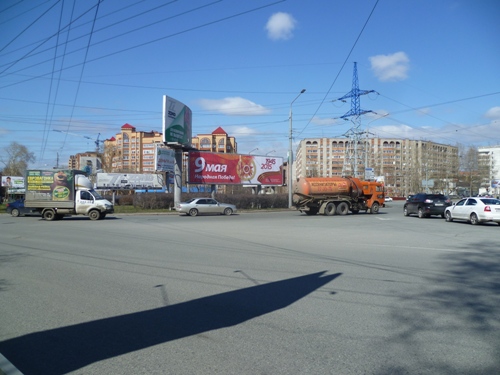
1. Транспортная площадь / Transport Square
Транспортная площадь в южной части города - едва ли не крупнейший дорожный перекрёсток Томска. Она же считается одним из самых аварийных мест города, в связи с чем здесь планируется создание двухуровневой дорожной развязки.
Transport Square in the southern part of the town - perhaps the major road intersection in Tomsk. It is considered one of the most emergency places in the town, so here is planned to create a two-tier road junction.
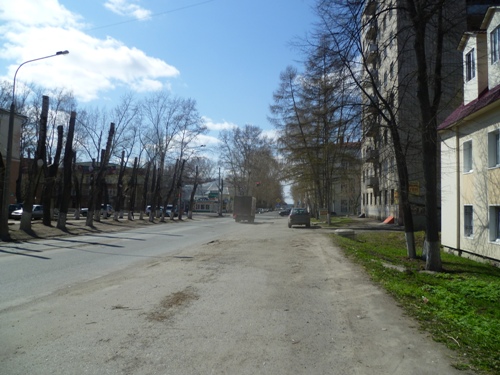
2. На улице Усова / At the Usov's Street
Улица Усова получила своё нынешнее название в 1939 году в честь академика М.А. Усова. Несколько домов в начале улицы носят статус памятников архитектуры регионального значения. А сама улица производит впечатление тихой, уютной и спокойной, хотя, возможно, причиной тому были праздничные дни.
Usov's Street got its present name in 1939 in honor of Academician M. A. Usov. Several houses in the beginning of the street have the status of architectural monuments of regional significance. And street itself gives the impression of a quiet and cozy, although the reason of it may have been holidays.
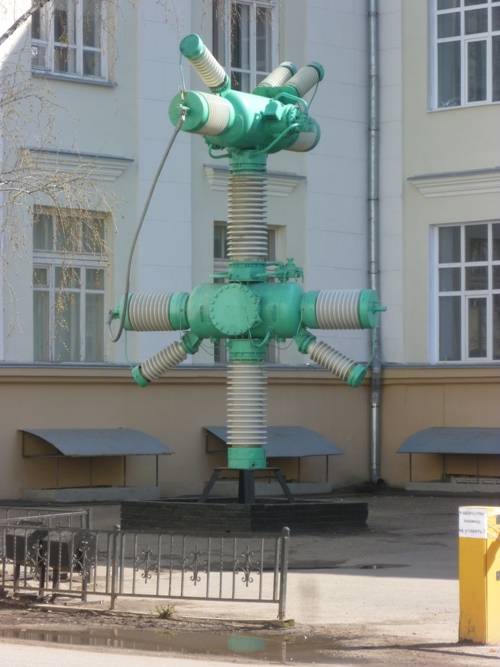
3. Памятник высоковольтному выключателю возле 8 корпуса Томского Политехнического Университета / Monument to the high-voltage switch near 8 building of Tomsk Polytechnic University
Один из множества оригинальных томских памятников установлен в 2006 году возле 8 корпуса томского политеха. Тематика выбрана неспроста, ведь в этом корпусе размещается Энергетический научно-исследовательский институт (подразделение политехнического университета).
One of the many original Tomsk monuments was set up in 2006 near eighth building of Tomsk Polytechnic University. Theme was chosen with an ulterior motive, because in this building is located Energy Research Institute (a division of Polytechnic University).
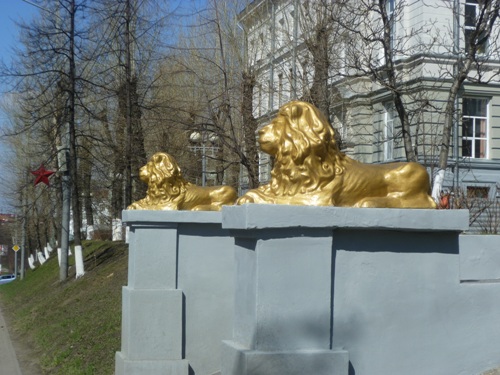
4. Эти львы охраняют подходы ко второму корпусу Томского Политехнического Университета / These lions guard the approaches to the second building of the Tomsk Polytechnic University
Львы - достаточно традиционный, но неизменно эффектный элемент городского декора. Такие бронзовые красавцы обосновались в ноябре 2009 года возле второго корпуса томского политеха, где нашёл своё пристанище химический факультет. Этот корпус был построен сразу после главного, даже раньше соседнего, "первого", корпуса.
Lions - quite traditional, but always spectacular element of urban decoration. These bronze handsome animals was appeared in November, 2009 near the second building of the Tomsk Polytechnic University, where chemical department found his refuge. This building was built immediately after the main building, even before the neighboring "first" building.
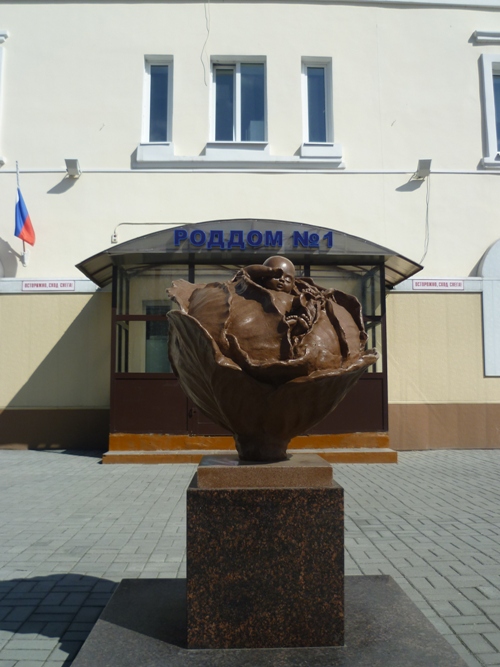
5. Памятник "Младенец в капусте" возле родильного дома №1 / Monument "The baby in a cabbage" near a maternity hospital №1
Этот памятник был открыт 15 мая 2008 года в рамках впервые проходившего в Томске празднования Дня семьи. На открытии автору композиции, скульптору Олегу Кислицкому, главным врачом первого роддома Татьяной Растохиной была выдана бирка с данными "новорождённого". Неудивительно, что этот памятник привлекает большое внимание молодожёнов и уже стал обрастать легендами и приметами.
This monument was opened on 15 May 2008 during first celebration in Tomsk of Day of the family. At the opening, the author of the composition, sculptor Oleg Kislitsky, got the tag with data of "newborn" from chief doctor of the first maternity hospital Tatiana Rastohina. Not surprisingly, this monument attracts attention of honeymooners and already has started to overgrow with legends and superstitions.
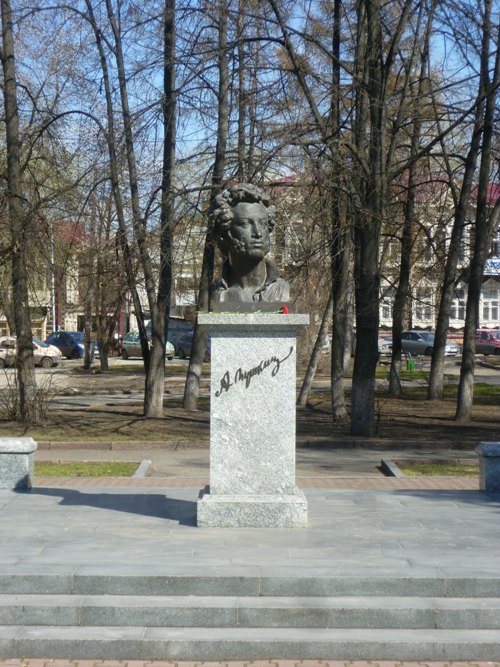
11. Памятник А.С. Пушкину возле Дворца бракосочетаний / Monument to A. S. Pushkin near the Wedding Palace
Этот памятник А.С.Пушкину был торжественно открыт 6 июня 1999 года, в день 200-летия со дня рождения поэта (в тот же день памятник поэту открывали и в Барнауле). По воспоминаниям сотрудника областной научной библиотеки имени Пушкина Эдуарда Майданюка памятник открывали с большим размахом, даже перекрыв на несколько часов проспект Ленина, одну из основных транспортных артерий города. Памятник расположился на площади между дворцом бракосочетания и краеведческим музеем. Автором скульптуры является Михаил Аникушкин.
This monument to Alexander Pushkin was opened on June 6, 1999, in the day of the 200th anniversary of the birth of the poet (the same day the monument to the poet was opened in Barnaul). According to memories of staff member of Regional Scientific Library named after Pushkin Eduard (Edward) Maydanyuk monument was opened with big way, even Lenin's Avenue, one of the main traffic arteries of the town, was closed for a few hours. The monument is located at the area between the wedding palace and local history museum. The author of the sculpture is Mikhail (Michael) Anikushkin.
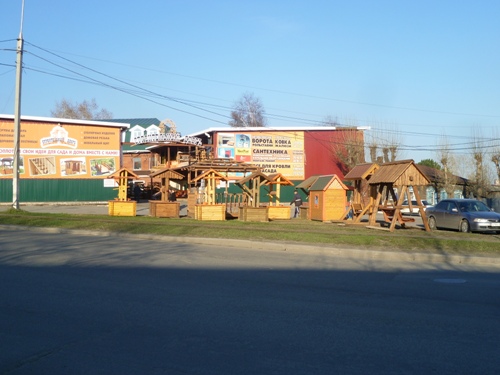
17. Своеобразная визитка магазина "Строительный дворъ" / Peculiar visiting card of the shop "Building yard"
Своеобразная выставка продукции рядом с магазином "Строительный дворъ", специализирующемуся на различных изделиях из древесины. В основном представлены колодезные срубы и качели под "козырьком".
The peculiar exhibition of products near the shop "Building yard", specializing in a variety of wood products. Basically represented well's blockhouses and swings under the "cap".
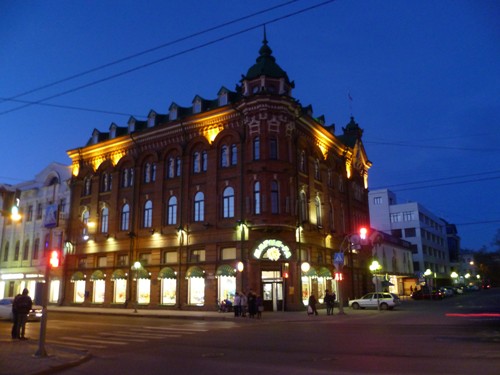
23. "Нижний гастроном" - бывший магазин купца Голованова / "Lower deli" - former shop of merchant Golovanov
На углу проспекта Ленина и переулка Нахановича расположено одно из красивейших каменных зданий Томска. Оно было построено в 1899 году по проекту архитектора Константина Лыгина для доходного дома купца Георгия Михайловича Голованова. Торговали в нём обувью, головными уборами и одеждой. После революции здесь сначала располагался кооперативный магазин, чуть позже - магазин ТОМТПО (томского транспортного потребительского общества, объединявшего железнодорожных служащих), а затем - "Гастроном №2". В постсоветское время (возможно, и чуть раньше) магазин вновь переименовался - на этот раз в "Нижний гастроном", кроме того, в этом же здании разместилась и городская дума Томска. К сожалению, в 2015 году историческая ниточка в некотором роде прервалась: помещение магазина было передано торговой сети "Мария-Ра". И, хотя под большой вывеской компании и сохранилась небольшая табличка "Нижний гастроном", это уже совсем не то. Очередная грустная история о том, как коммерция победила историю и романтику.
At the corner of Lenin's Avenue and Nahanovich's Side Street is located one of the most beautiful stone buildings in Tomsk. It was built in 1899 by architect Konstantin Lygin for trade house of merchant Georgiy Mikhailovich Golovanov. Here were being traded with footwear, headgear and clothing. At once after the revolution here was cooperative store, a little later - store of TOMTCS (Tomsk transportation consumer society, uniting railway employees), and then - "Deli №2". In the post-Soviet period (possibly a little earlier) store changed its name again - this time to the "Lower deli", moreover, Tomsk Town Council was moved to the same building. Unfortunately, in 2015, the historical thread, in some way, was interrupted: the shop was transferred to the trading network "Maria-Ra". And though under the big signboard of company was saved a small plate "Lower deli", that's not the same. Another sad story about how commerce has defeated the history and romance.
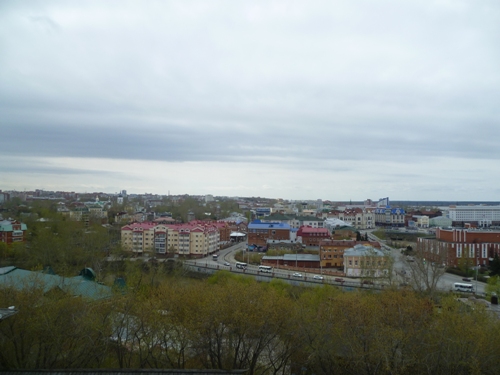
24. Набережная Ушайки с каланчи музея истории Томска / Naberezhnaya Ushayki (Ushayka's Embankment) Street from belfry of museum of history of Tomsk
С вершины пожарной каланчи, расположенной на территории музея истории Томска на Воскресенской горе, во все стороны открывается впечатляющий вид на город. В частности, и на небольшой отрезок улицы Набережная Ушайки, закономерно протянувшейся вдоль соответствующей реки.
From the top of the fire tower located on the territory of the Museum of the History of Tomsk on Voskresenskaya (Ressurection) mount in all directions offers spectacular views of the town. In particular, and at a small section of the street called Naberezhnaya Ushayki (Ushayka's Embankment), stretching along the respective river.
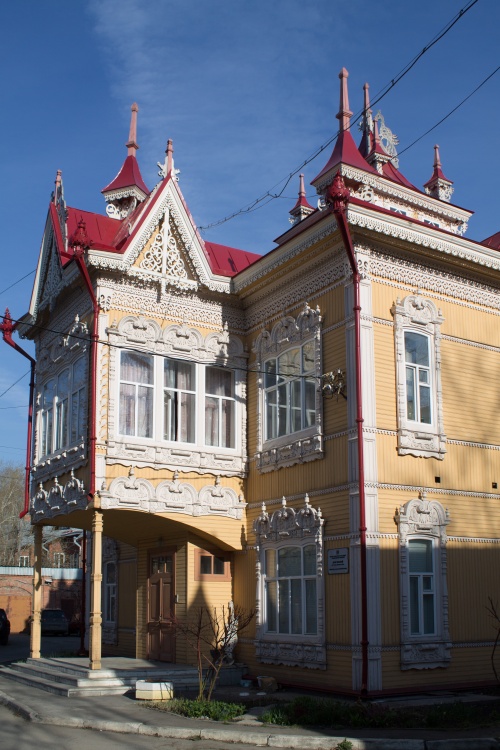
30. Флигель купеческой усадьбы Л. Д. Желябо / The outbuilding of the merchant's estate of L. D. Zhelyabo
Дом по адресу "улица Красноармейская, 67/1" - это едва ли не самый яркий памятник деревянного зодчества в Томске. Он был построен в 1903 году во внутреннем дворе усадьбы купца Леонтия Желябо по проекту главного архитектора Томска Петра Федоровского (который сам по себе - личность примечательная, закончил Петербургскую академию художеств, обучался у известного русского художника Александра Бенуа). Постановлением Совета Министров РСФСР №624 от 4 декабря 1974 года дом был включен в список архитектурных памятников федерального значения.
The house at "Krasnoarmeyskaya (Red Army) street, 67/1" maybe is the most outstanding monument of wooden architecture in Tomsk. It was built in 1903 in the courtyard of the estate of merchant Leonty Zhelyabo by the project of the chief architect of Tomsk, Petr (Peter) Fedorovsky (who itself is a remarkable person, graduated from the St. Petersburg Academy of Arts, studied with the famous Russian artist Alexander Benois). By Decree of the Council of Ministers of the RUFSR No. 624 of December 4, 1974 the house was included in the list of architectural monuments of federal significance.

31. Дом с жар-птицами / House with fire birds
Помимо этого дома, известного в Томске и как "дом с жар-птицами", в состав ансамбля усадьбы Леонтия Желябо входило ещё три дома. И у каждого из этих домов - сложная судьба. Из четырёх строений лишь тот самый "дом с жар-птицами" сохранил свою аутентичность до наших дней, ещё два здания усадьбы представляют собой реконструкции на месте старых зданий, осуществлённые в 80-е годы по программе "Старый Томск", но больше всего не повезло зданию по адресу "улица Красноармейская, 65/1" - сначала пришедший в полную негодность дом был расселён, затем земельный участок под ним был продан на аукционе, а в итоге на месте деревянного домика был выстроен бетонный новодел, обшитый тесом. Городская администрация планировала через суд добиться сноса новостройки и восстановления архитектурного памятника, однако, судя по тому, что дом стоит, как стоял, ничего из этой затеи не вышло. Под угрозой было и существование последнего оригинального здания в ансамбле усадьбы. К 2008 году "дом с жар-птицами" очень серьёзно обветшал после последнего ремонта. Особенно сложная ситуация сложилась с крышей здания, пришедшей практически в полную негодность. Спасли дом лишь старательность и настойчивость его жильцов, внимание общественности и СМИ, а также отвалившийся от потолка во время очередного дождя и чудом никого не прибивший кусок штукатурки. В итоге всё-таки было принято решение о ремонте и реставрации дома, проведённых в два этапа.
In addition to this house, known in Tomsk as a "house with fire birds," the ensemble of the estate of Leonty Zhelyabo included three more houses. And each of these houses had a difficult destiny. Of the four buildings, only that "house with fire birds" has retained its authenticity to our days, two more buildings of the estate are reconstructions on the site of old buildings that were carried out in the 80s under the program "Old Tomsk", but the most sad fate befell to the building at "Krasnoarmeyskaya (Red Army) Street, 65/1" - first of all, the house, that became completely unfitness, was settled out, then the land plot under it was sold at auction, and in the end, a concrete replica was built on the site of the wooden house. The town administration planned through the court to demolish the new building and restore the architectural monument, however, judging by the fact that the house stands as it stood earlier, nothing came of this venture. The existence of the last original building in the ensemble of the estate was also under threat. By 2008, the "house with fire birds" had decayed very seriously after the last repair. Particularly difficult situation arose with the roof of the building, which came almost completely out of order. The house was saved only by the diligence and perseverance of its residents, the attention of the public and the media, and also by a piece of plaster, which fell off the ceiling during the rain and miraculously slamed nobody. As a result, it was finally did a decision about repair and restoration of the house, that were conducted in two stages.
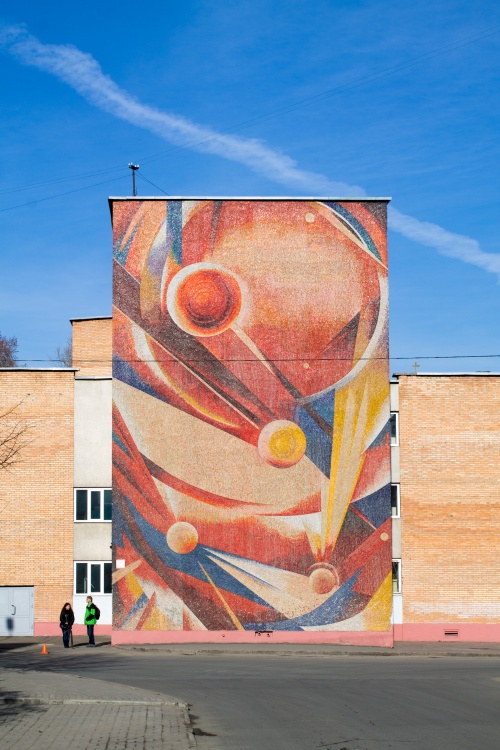
32. Монументальная мозаика "Парад планет" / Monumental mosaic "The Parade of the Planets"
Новое здание томского Дворца пионеров было торжественно открыто 8 февраля 1980 года. А в 1987 году на одной из его стен появилость эпичное мозаичное полотно "Парад планет" за авторством Николая Беглюка. Как вспоминает сам автор, наиболее сложным во всей работе над мозаикой было найти общий язык с заказчиком. По его словам, до него это не удалось как минимум трём другим художникам. Облком КПСС настаивал на традиционной пионерской символике с горнами и знамёнами, но Беглюку удалось настоять на своей идее о пионерах, как первопроходцах, метафорично выраженной через образ космоса. Это позволило создать работу, не привязанную к символам эпохи, что делает её ещё более ценной. Сами работы по укладке смальты заняли всего лишь около четырёх месяцев. Позднее, уже в 2000-х годах была проведена незначительная реставрация мозаики - слишком большое число элементов на высоте человеческого роста было растащено на сувениры.
The new building of the Tomsk Palace of Pioneers was solemnly opened on February 8, 1980. And in 1987, on one of its walls appeared an epic mosaic painting "The Parade of the Planets" for the authorship of Nikolay Beglyuk. As the author himself recalls, the most difficult part of the whole work on the mosaic was to find a common language with the customer. According to him, at least three other artists hadn't be able to do it before him. The regional committee of CPSU wanted traditional pioneer symbols with bugles and banners, but Beglyuk managed to insist on his idea of pioneers as first researchers, metaphorically expressed through the image of the cosmos. This allowed him to create a work that is not tied to the symbols of the era, which makes it even more valuable. The works on laying smalt took only about four months. Later, already in the 2000s, an insignificant restoration of the mosaic was carried out - too many elements at the height of human height were chipped for souvenirs.
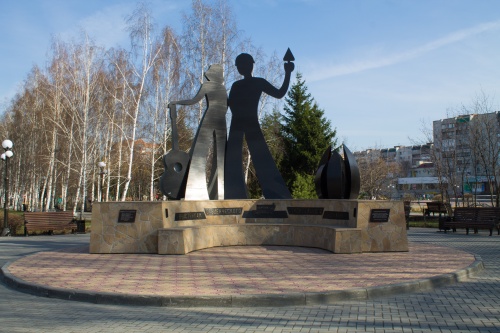
33. Памятник студенческим стройотрядам / Monument to student construction squads
В 2013 году, в 50-летнюю годовщину томских студенческих стройотрядов, был серьёзно реконструирован сквер рядом с Дворцом спорта. Венцом реконструкции стало открытие 7 сентября того же года памятника участникам стройотрядовского движения, созданного по эскизу скульптора Антона Гнедых. В основание памятника также была заложена "капсула времени" с посланием к столетию движения.
In 2013, on the 50th anniversary of the Tomsk student construction squads, the square near Sports Palace was seriously reconstructed. The crowning of the reconstruction was the opening on September 7 of the same year of a monument to the members of the construction squad movement, created according to the sketch of the sculptor Anton Gnedykh. At the base of the monument was also laid the "time capsule" with a message to the centenary of the movement.
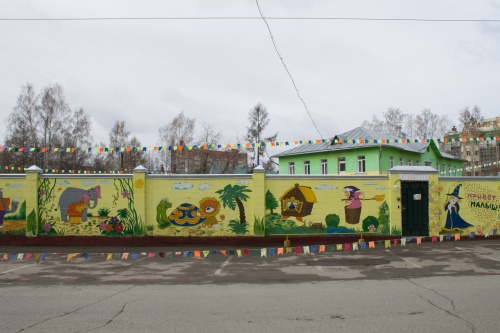
36. Разрисованный забор возле Центра раннего развития "Созвездие" / Fence with paintings near the Center for Early Development "Constellation"
При обустройстве летом 2016 года капитального забора возле Центра раннего развития "Созвездие" и детского сада №40 его уличную сторону разрисовали героями известных отечественных сказок и мультфильмов. Само по себе возведение такого забора связано с ужасным резонансным событием летом 2014 года, когда трёхлетняя девочка была похищена прямо с территории детского сада №46 и впоследствии найдена убитой. Именно после того события городская администрация инициировала обустройство детских дошкольных учреждений средствами видеонаблюдения, а также обустройство новых ограждений.
With the arrangement in summer 2016 of a concrete fence near the Center for Early Development "Constellation" and kindergarten №40, its street side was painted with heroes of famous Russian fairytales and cartoons. The very construction of such a fence is associated with a terrible resonance event in the summer of 2014, when a three-year-old girl was kidnapped directly from the territory of kindergarten №46 and subsequently was found dead. It was after that incident that the town administration initiated the arrangement of children's preschool institutions with video surveillance equipment, as well as the arrangement of new fences.
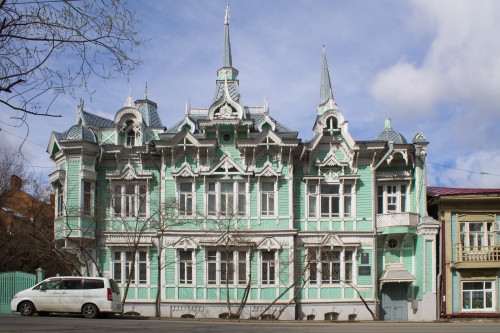
37. Особняк архитектора С. В. Хомича / The mansion of architect S. V. Khomich
Здание, построенное для себя и своей семьи в 1904 году архитектором С. В. Хомичем - ещё один томский архитектурный памятник федерального значения. Архитектор с семьёй проживал в нём до 1914 года, параллельно сдавая часть помещений под частные квартиры. В дальнейшем здание частенько изменяло свой профиль: в 1924 году здесь располагался Эксплуатационный техникум Томской железной дороги, затем здание служило общежитием для студентов ТГУ, во второй половине 30-х годов здесь квартировали видные медицинские работники, долгое время здание занимали дом ребёнка №3, а потом Областная детская больница. В 90-х годах здание передали Лицензионной палате Томской области с условием проведения реставрационных работ. Нынче, рассказывая об этом доме, томичи частенько вспоминают одну из городских легенд: якобы архитектурные кружева томских деревянных домов и покрашенные в зелёный цвет крыши и ограды послужили одним из источников вдохновения для адаптации Александром Волковым сказок Лаймэна Фрэнка Баума в форме "Волшебника изумрудного города".
The house, built for himself and his family in 1904 by architect S. V. Khomich, is another Tomsk architectural monument of federal significance. The architect with his family lived in it until 1914, while renting out part of the premises for private apartments. Further the building was changing its profile quite often: in 1924 it was housing the Exploitation college of Tomsk railroad, then the building was serving as a hostel for TSU students. In the second half of the 30s, prominent medical workers was lodging here, for a long time the building was occupied by the child's house №3, and Then Regional Children's Infirmary. In the 90s the building was handed over to the Licensing Chamber of the Tomsk Region with the condition of carrying out restoration work. Today, telling about this house, Tomsk townpeople often recalled one of the town's legends: ostensibly architectural laces of Tomsk wooden houses and painted in green roofs and fences had served as one of the sources of inspiration for Alexander Volkov's adaptation of fairy tales of Laiman Frank Baum in the form of "The Wizard of the Emerald City."
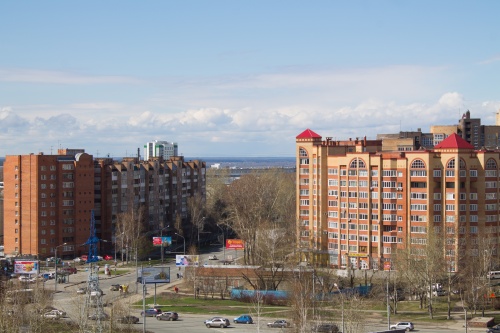
38. Томск в начале мая / Tomsk in early May
Хотя здание нового корпуса Томского университета систем управления и радиоэлектроники и не является локальной архитектурной доминантой, но из окон его верхних этажей можно бросить неплохой взгляд на центр города. Конечно, обзору серьёзно мешают многоэтажки в районе Транспортной площади, но, тем не менее, за ними можно разглядеть кварталы пятиэтажных хрущёвок, а ближе к Томи - и невысокие деревянные домики старого города. На дворе - самое начало мая, поэтому урбанистические черты города ещё не скрыты покровом древесной листвы.
Although the new building of the Tomsk University of Control Systems and Radioelectronics is not a local architectural dominant, but from the windows of its upper floors you can throw a good look at the town center. Of course, high-rise buildings in the area of Transport Square is seriously interfering with visibility, but nevertheless, behind them you can see the quarters of five-stories Khrushchev-style buildings, and closer to Tom - the low wooden houses of the old town. In the picture is the very beginning of May, so the urban features are not hidden by the cover of foliage.


